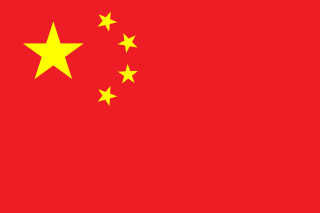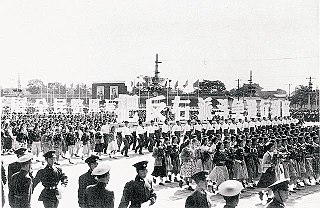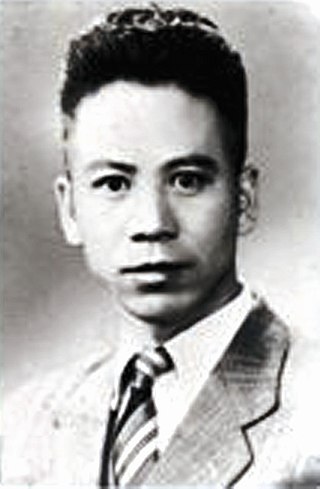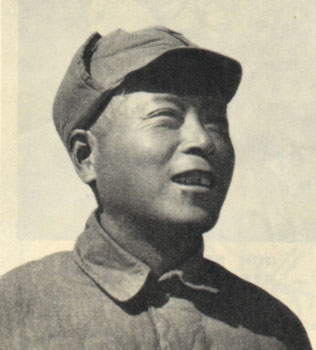
Shen Dehong, known by the pen name of Mao Dun, was a Chinese essayist, journalist, novelist, and playwright. Mao Dun, as a 20th-century Chinese novelist, literary and cultural critic, and Minister of Culture (1949–65), was one of the most celebrated left-wing realist novelists of modern China. His most famous work is Midnight (子夜), a novel depicting life in cosmopolitan Shanghai. It is also considered to be the work with the greatest influence on his future writing. Furthermore, during the period in which he was writing Midnight, Mao Dun formed a strong friendship with another of China's most famous writers, Lu Xun.

The time period in China from the founding of the People's Republic in 1949 until Mao's death in 1976 is commonly known as Maoist China and Red China. The history of the People's Republic of China is often divided distinctly by historians into the Mao era and the post-Mao era. The country's Mao era lasted from the founding of the People's republic on 1 October 1949 to Deng Xiaoping's consolidation of power and policy reversal at the Third Plenum of the 11th Party Congress on 22 December 1978. The Mao era focuses on Mao Zedong's social movements from the early 1950s on, including land reform, the Great Leap Forward and the Cultural Revolution. The Great Chinese Famine, one of the worst famines in human history, occurred during this era.
The Hundred Flowers Campaign, also termed the Hundred Flowers Movement, was a period from 1956 to 1957 in the People's Republic of China during which the Chinese Communist Party (CCP) encouraged citizens to openly express their opinions of the Communist Party. Following the failure of the campaign, CCP Chairman Mao Zedong conducted an ideological crackdown on those who criticized the party, which continued through 1959.

The Anti-Rightist Campaign in the People's Republic of China, which lasted from 1957 to roughly 1959, was a political campaign to purge alleged "Rightists" within the Chinese Communist Party (CCP) and the country as a whole. The campaign was launched by Chairman Mao Zedong, but Deng Xiaoping and Peng Zhen also played an important role. The Anti-Rightist Campaign significantly damaged democracy in China and turned the country into a de facto one-party state.
The New Culture Movement was a movement in China in the 1910s and 1920s that criticized classical Chinese ideas and promoted a new Chinese culture based upon progressive, modern ideals like elections and science. Arising out of disillusionment with traditional Chinese culture following the failure of the Republic of China to address China's problems, it featured scholars such as Chen Duxiu, Cai Yuanpei, Chen Hengzhe, Li Dazhao, Lu Xun, Zhou Zuoren, He Dong, Qian Xuantong, Liu Bannong, Bing Xin, and Hu Shih, many classically educated, who led a revolt against Confucianism. The movement was launched by the writers of New Youth magazine, where these intellectuals promoted a new society based on unconstrained individuals rather than the traditional Confucian system. The movement promoted:
From November 1978 to December 1979, thousands of people put up "big character posters" on a long brick wall of Xidan Street, Xicheng District of Beijing, to protest about the political and social issues of China. Under acquiescence of the Chinese government, other kinds of protest activities, such as unofficial journals, petitions, and demonstrations, were also soon spreading out in major cities of China. This movement can be seen as the beginning of the Chinese Democracy Movement. It is also known as the "Democracy Wall Movement". This short period of political liberation was known as the "Beijing Spring".

Chen Boda, was a Chinese Communist journalist, professor and political theorist who rose to power as the chief interpreter of Maoism in the first 20 years of the People's Republic of China. Chen became a close associate of Mao Zedong in Yan'an, during the late 1930s, drafting speeches and theoretical essays and directing propaganda.

Zheng Zhenduo, courtesy name Xidi, was a Chinese journalist, writer, archaeologist and scholar. His pen names were Baofen (寶芬), Guo Yuanxin (郭源新) and CT.

Chu Anping was a Chinese scholar, liberal journalist and editor of Guancha in the Civil War era of the late 1940s. He is widely considered to be one of the most famous liberals in China. He was Editor of the China Democratic League newspaper "for intellectuals", the Guangming Daily, in the PRC era. Following publication of his article entitled "The Party Dominates the World", he was attacked by Mao Zedong in the Hundred Flowers Campaign of 1957 and purged during the Anti-Rightist Movement. It is believed that he committed suicide in 1966. He was father to Chu Wanghua (储望华), a contemporary Chinese composer based in Australia, and grandfather to Mark Chu, a multidisciplinary artist.
Scar literature or literature of the wounded is a genre of Chinese literature which emerged in the late 1970s during the "Boluan Fanzheng" period, soon after the death of Mao Zedong, portraying the sufferings of cadres and intellectuals during the experiences of the Cultural Revolution and the rule of the Gang of Four.

Mao Dun Literature Prize is a prize for novels, established in the will of prominent Chinese writer Mao Dun and sponsored by the China Writers Association. Awarded every four years, it is one of the most prestigious literature prizes in China. It was first awarded in 1982.
The Fiction Monthly was a Chinese literary journal published by the Commercial Press in Shanghai. First published in July 1910, its original editors were Yun Tieqiao (恽铁樵) and Wang Chunnong (王莼农). In January 1921, Mao Dun became its chief editor beginning with Volume 10, Issue 1. Fiction Monthly closed its doors in 1932 after the Japanese invasion of Shanghai with their naval and air bombardment. Altogether there were 22 volumes or 262 issues, including four specials.
China Writers Association or Chinese Writers Association is a subordinate people's organization of the China Federation of Literary and Art Circles (CFLAC). Founded in July 1949, the organization was initially named the China National Literature Workers Association. In September 1953, it was renamed the China Writers Association. The association's leadership was purged shortly after the 1989 Tiananmen Square protests and massacre. In April 2012, the organization changed its translated name to China Writers Association.

Yao Xueyin was a Chinese novelist who was a member of China Writers Association. Yao was a member of the 5th, 6th, and 7th National Committee of the Chinese People's Political Consultative Conference. Yao used his fortune posthumously to institute the Yao Xueyin Historical Novel Prize (姚雪垠长篇历史小说奖).

Li Jingquan was a Chinese politician and the first Party Committee Secretary (governor) of Sichuan following the establishment of the People's Republic of China in 1949. He supported many of Mao Zedong's policies including the Great Leap Forward.

Chen Xuezhao was a Chinese writer and journalist. She was earlier known as Chen Shuzhang or Chen Shuying. She used the pen names Ye Qu, Shi Wei, Xue Zhao and Hui. She was one of the most prolific Chinese women writers of the 20th century. Chen gave her support to Mao Zedong's policy on Art and Literature.

Scarlet Memorial: Tales of Cannibalism in Modern China is a book of reportage literature by the Chinese novelist Zheng Yi. Zheng and a group of writers under the joint pseudonym "T. P. Sym" translated and abridged it from the Chinese work 红色 纪念碑 Hongse jinianbei. Zheng uses local government documents, eye-witness accounts and confessions to describe the factional violence and even cannibalism that occurred in the Guangxi Massacre during the Cultural Revolution (1966–1976).

Feng Yidai was a Chinese author, editor, and translator. Born in Hangzhou, he studied in Shanghai and thereafter began an illustrious career in publishing and editing. He was denounced as a "rightist" during Mao Zedong's Anti-Rightist Campaign. He was politically rehabilitated after the Cultural Revolution and resumed his literary career. He married the actress and writer Huang Zongying in 1993. A few years before his death, he published his diaries and confessed his secret role as a government spy during the Anti-Rightist Campaign.

Mao Zedong's cult of personality was a prominent part of Chairman Mao Zedong's rule over the People's Republic of China from his rise in 1949 until his death in 1976. Mass media, propaganda and a series of other techniques were used by the state to elevate Mao Zedong's status to that of an infallible heroic leader, who could stand up against The West, and guide China to become a beacon of Communism. Mao himself, however, publicly criticized the personality cult which was formed around him.
The Shengwulian or Sheng-wu-lien was a radical ultra-left group formed in 1967 during the Cultural Revolution. The rebel group became known for its opposition to local authorities installed by Beijing and for creatively re-interpreting the Cultural Revolution's official doctrine, becoming active during a period when the political trends of the Cultural Revolution were moving away from mass political mobilization.














